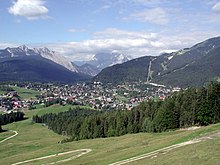Plateau 47°19′43″N11°11′34″E / 47.32861°N 11.19278°E
Contents

The Seefeld Plateau (German : Seefelder Plateau) is a montane valley and basin landscape in the North Tyrolean Limestone Alps about 500 metres above the Inn valley in the Austrian state of Tyrol. The plateau covers the valley basin around the villages of Seefeld in Tirol and Scharnitz as well as the valley of Leutaschtal.


